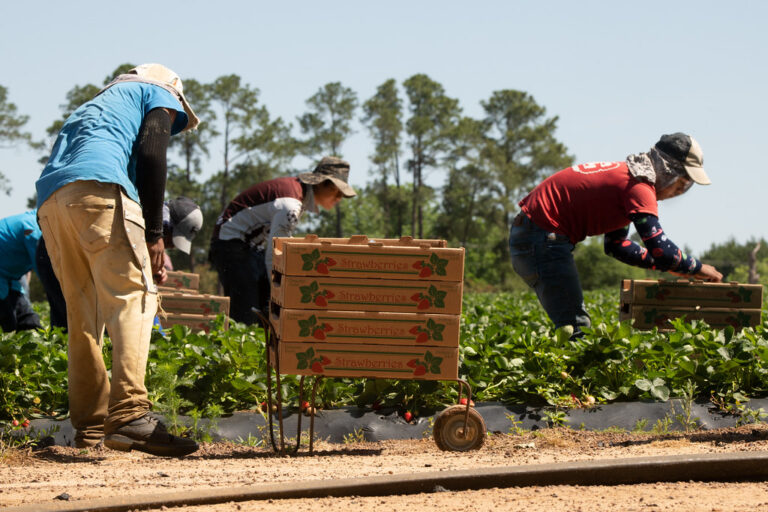
Tascha Shahriari-Parsa is a government lawyer enforcing workers’ rights laws. He clerked on the Supreme Court of California after graduating from Harvard Law School in 2024. His writing on this blog reflects his personal views only.
“We contracted farm workers are living through modern-day slavery. We don’t have water, work many hours with a small salary, don’t have breaks, and there’s not enough bathrooms.”
These are the words of Manuel, a farmworker in North Carolina on a temporary agricultural workers’ visa (formally, an H–2A visa). He usually worked 58-hour weeks without receiving any overtime pay. Other weeks, without any prior notice, his employer would inform him that the work wasn’t ready for him to do—and he wouldn’t be paid at all.
Manuel wanted to do something about his stolen wages, but he feared losing his job if he spoke up. His employer had made him and other workers sign a contract stipulating that they couldn’t meet with unions. His supervisor threatened that he would be fired if he did. So, he stayed silent.
Manuel is just one of 370,000 workers who will finally have a protected voice at work under a new Department of Labor rule. Starting on August 29, an agricultural employer will not be able to hire temporary foreign workers unless it guarantees that it “has not and will not intimidate, threaten, restrain, coerce, blacklist, discharge or in any manner discriminate against…any person because such person…[h]as engaged in activities related to self-organization, including any effort to form, join, or assist a labor organization; or has engaged in other concerted activities for the purpose of mutual aid or protection relating to wages or working conditions….”
In other words, the new rule gives temporary farmworkers the right to organize.
In addition to helping H–2A workers like Manuel, the rule benefits U.S. farmworkers by preventing a race to the bottom in the labor market. Before, if U.S. farmworkers demanded better pay or working conditions, their employer could replace them with temporary workers who are more vulnerable to exploitation. This looming threat of replacement discouraged U.S. farmworkers from organizing in the first place. But under the Department of Labor rule, which makes temporary farmworkers harder to exploit, U.S. farmworkers will be able to organize without the same threat of being displaced by a more vulnerable workforce.
This benefit to U.S. workers is also what authorizes the Department to enact the rule. Since 1986, the Immigration and Nationality Act (INA) has authorized the admission of temporary, nonimmigrant farmworkers on H–2A visas to work for agricultural employers. But it allows a visa to be issued to a foreign farmworker only after the Secretary of Labor has certified that (1) no U.S. worker is available for the job and (2) that the employment of the temporary worker “will not adversely affect the wages and working conditions of workers in the United States similarly employed.”
The second prong is where the Department locates its authority. When an agricultural employer seeks to bring in temporary foreign workers, the Department has trouble determining if it’s because they genuinely can’t find anyone to do the job or because they intend to undermine workplace standards by turning to a more precarious labor pool. To be sure it’s not the latter motive, the Department asks agricultural employers to agree to certain conditions before inviting foreign workers.
These conditions already included paying temporary farmworkers the prevailing wage rate and not retaliating against those who exercise their legal rights. But when the Department investigates agricultural employers, they “typically do[] not find full compliance with the law, with back wages averaging several hundred dollars owed per worker.”
The Department has limited resources to investigate employers, so they rely on workers to advocate for their own rights. But, as the Department notes, “the temporary nature of the work, frequent geographic isolation of the workers, and dependency on a single employer” make organizing a “uniquely difficult” undertaking for temporary farmworkers. And as the AFL-CIO put it, having guarantees “on paper means nothing if the H–2A workers are unable or unwilling because of fear and intimidation to take action” when their rights are undermined.
Thus, the new rule prohibits employers from threatening, intimidating, or discriminating against workers who organize around workplace issues. Combined with existing rules, this will deter agricultural employers from undercutting workers like Manuel and thereby “neutralize any ‘adverse effect’” on U.S. workers as well.
Despite the Department’s clear authority to enact this rule, we can anticipate two key legal challenges. The first is that the National Labor Relations Act “preempts” the rule. The second is that the rule runs afoul of the major questions doctrine. Upon inspection, neither has merit.
First, the NLRA excludes farmworkers from its statutory definition of “employees”—those granted organizing rights under the statute. Thus, opponents of the rule contend that it defies Congress’s intent to leave agricultural workers free of federal organizing protections.
This assertion runs into a big obstacle: courts have uniformly held that the NLRA’s farmworker exclusion expressed Congress’s indifference to agricultural workers’ organizing rights. That’s why several states have given farmworkers organizing rights, and courts have upheld them. But according to the Chamber of Commerce, Congress “wanted working conditions in the agricultural sector to be determined” by non-federal actors. Those “might include state governments,” but do “not include other federal agencies.”
This argument is not new, and it has already failed. In 2010, the Department promulgated a rule (under the authority of the Procurement Act) requiring federal contractors to post workplace notices about federal labor rights. Like here, challengers argued that the NLRA—which does not include such a requirement—preempted the rule. The court was not convinced: because “Congress did not intend for the NLRA to wholly occupy the field,” the NLRA blocked neither states nor federal agencies from taking action. The same logic applies here.
Second, some commentators argue that the Department lacks authority to issue the farmworker protection rule under the major questions doctrine, which holds that an agency must “point to clear congressional authorization” in “extraordinary cases” of “economic and political significance.” The doctrine is generally triggered when agency action involves novelty, lack of fit, or breadth—none of which appear here. The Department has a long history of regulating temporary farmworkers’ labor rights under the INA; it is regulating in an area of its expertise; and the rule’s coverage is limited to H–2A program participants, a tiny subset of the workforce.
The Department has also narrowed the rule’s ambit. The rule does not give workers collective bargaining rights. It does not preempt state labor laws (so a temporary farmworker in New York is still prohibited from striking). Unlike the original proposed rule, it does not require “employers to provide worker contact information to a requesting labor organization” or guarantee labor organizations “access to worker housing.” And it stops short of banning employers’ captive audience meetings, simply giving employees the right to leave them.
Despite these limitations, the rule goes a long way to ensure that all farmworkers, no matter their immigration or visa status, can speak up. As in any workplace, speaking up demands courage. It demands organizing, even just to ensure that farmworkers are aware of their newfound rights. But now, there’s hope that workers like Manuel—workers who face abuse and exploitation while cultivating the food we eat every day—will stand a chance when they stand up.







Daily News & Commentary
Start your day with our roundup of the latest labor developments. See all
January 5
Minor league hockey players strike and win new deal; Hochul endorses no tax on tips; Trump administration drops appeal concerning layoffs.
December 22
Worker-friendly legislation enacted in New York; UW Professor wins free speech case; Trucking company ordered to pay $23 million to Teamsters.
December 21
Argentine unions march against labor law reform; WNBA players vote to authorize a strike; and the NLRB prepares to clear its backlog.
December 19
Labor law professors file an amici curiae and the NLRB regains quorum.
December 18
New Jersey adopts disparate impact rules; Teamsters oppose railroad merger; court pauses more shutdown layoffs.
December 17
The TSA suspends a labor union representing 47,000 officers for a second time; the Trump administration seeks to recruit over 1,000 artificial intelligence experts to the federal workforce; and the New York Times reports on the tumultuous changes that U.S. labor relations has seen over the past year.